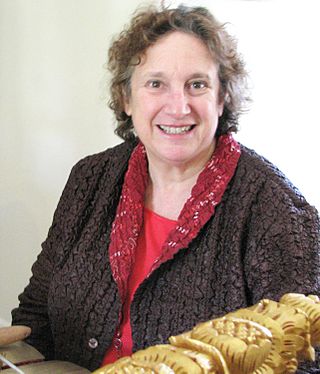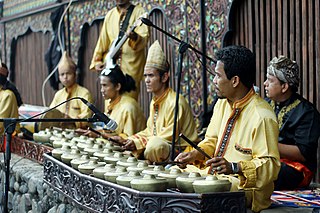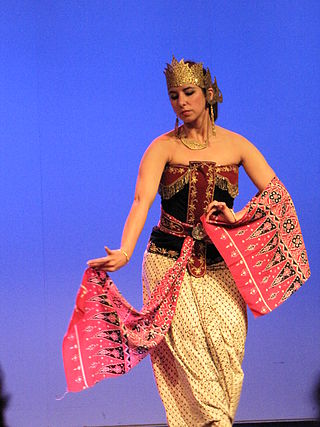Related Research Articles

Gamelan is the traditional ensemble music of the Javanese, Sundanese, and Balinese peoples of Indonesia, made up predominantly of percussive instruments. The most common instruments used are metallophones played by mallets and a set of hand-played drums called kendhang/Kendang, which register the beat. The kemanak and gangsa are commonly used gamelan instruments in Bali. Other instruments include xylophones, bamboo flutes, a bowed instrument called a rebab, a zither-like instrument siter and vocalists named sindhen (female) or gerong (male).
Prof. Dr. I Made Bandem is a Balinese dancer, artist, author, and educator.

Mantle Hood was an American ethnomusicologist. Among other areas, he specialized in studying gamelan music from Indonesia. Hood pioneered, in the 1950s and 1960s, a new approach to the study of music, and the creation of the first American university program devoted to ethnomusicology, at the University of California, Los Angeles (UCLA). He was known for a suggestion, somewhat novel at the time, that his students learn to play the music they were studying.

Jody Diamond is an American composer, performer, writer, publisher, editor, and educator. She specializes in traditional and new music for Indonesian gamelan and is active internationally as a scholar, performer, and publisher.
The Indonesia Institute of the Arts, Yogyakarta is a state-owned college in Bantul Regency, Special Region of Yogyakarta, Indonesia. It teaches visual, performing, and media arts in traditional Indonesian and modern international styles. ISI Yogyakarta was ranked number one in Indonesia on the QS World's Top Performing Arts Schools in 2022.

Talempong is a traditional music of the Minangkabau people of Western Sumatra, Indonesia. The talempong produce a static texture consisting of interlocking rhythms.

The balungan is sometimes called the "core melody" or, "skeletal melodic outline," of a Javanese gamelan composition. This corresponds to the view that gamelan music is heterophonic: the balungan is then the melody which is being elaborated. "An abstraction of the inner melody felt by musicians," the balungan is, "the part most frequently notated by Javanese musicians, and the only one likely to be used in performance."
Irama is the term used for tempo in Indonesian gamelan in Java and Bali. It can be used with elaborating instruments. It is a concept used in Javanese gamelan music, describing melodic tempo and relationships in density between the balungan, elaborating instruments, and gong structure. It is distinct from tempo, as each Irama can be played in different tempi. Irama thus combines "the rate of temporal flow and temporal density"; and the temporal density is the primary factor.
Imbal or imbalan is a technique used in Indonesian Javanese gamelan. It refers to a rapid alternation of a melodic line between instruments, in a way similar to hocket in medieval music or kotekan in Balinese gamelan. "A style of playing in which two identical or similar instruments play interlocking parts forming a single repetitive melodic pattern."
This imbal is a method of playing in which the nuclear theme is played by one of the nyaga's 'broken up' into half-values, what time another player beats alternately with the first, but in such a way that his tones, each of which comes between two of his colleague's, are always one step lower than the nuclear theme tone immediately preceding it. From practical considerations this imbal is, if possible, divided over two demungs; if only one such instrument is available, the two players sit facing each other. The player who beats the nuclear theme tones is said to play the gawé (...); the other one, the nginţil (...).

Kanjeng Pangeran Harjo Notoprojo, also known as Tjokrowasito, Wasitodipuro, Wasitodiningrat, among other names, was one of the most highly respected performers of Javanese gamelan. He led the Paku Alaman palace gamelan as well as the gamelan for the Radio Republik Indonesia Yogyakarta, and taught gamelan in universities around the world. He was also a noted composer and rebab performer.

The bedhaya is a sacred, ritualised Javanese dance of Java, Indonesia, associated with the royal palaces of Yogyakarta and Surakarta. Along with the srimpi, the bedhaya epitomized the elegant character of the royal court and became an important symbol of the ruler's power.

Indonesian Institute of the Arts, Surakarta is an arts university in Surakarta, Central Java, Indonesia. They are famous for teaching karawitan, wayang, Javanese dance, and other traditional crafts. The rector is Dr. Drs Guntur, M.Hum.
Javanese poetry is traditionally recited in song form. The standard forms are divided into three types, sekar ageng, sekar madya, and sekar macapat, also common with the ngoko terms: tembang gedhé, tembang tengahan, and tembang macapat. All three types follow strict rules of poetic construction. These forms are highly influential in Javanese gamelan.

Gamelan, although Indonesia is its origin place, is found outside of that country. There are forms of gamelan that have developed outside Indonesia, such as American gamelan and Malay Gamelan in Malaysia.
(Joseph) Vincent McDermott was a classically trained American composer and ethnomusicologist. His works show particular influence from the musics of South and Southeast Asia, particularly the gamelan music of Java. He was among the second generation of American composers to create and promote new compositions for gamelan.

The Gamelan Sekaten is a ceremonial gamelan from central Java, Indonesia, played during the annual Sekaten festival. The word "sekaten" itself is derived from syahadatain or shahada, the first requirement for converting into Islamic faith. Traditionally it is played once per year, on the occasion of Mawlid, Muhammad's birthday, for the week from the 6-12 of the month of Mulud. On this celebration it is brought from the palace at 11 pm to two pavilions before the Great Mosque. It is played every day during that week except the Thursday night/Friday morning. On the eve of the birthday proper, it is returned at 11 pm.

The Sonobudoyo Museum is a Javanese history and culture museum and library in Yogyakarta, Indonesia. The museum contains the most complete collection of Javanese artifacts, after the National Museum in Jakarta. In addition to ceramics of the Neolithic era and bronze sculptures from the 8th century, the museum also includes collections of wayang, various ancient weapons, and Javanese masks.
John Pemberton is an associate professor of anthropology at Columbia University. He received a Ph.D. from Cornell University after doing undergraduate and Masters' work at Wesleyan University and being associated with the music program at California Institute for the Arts. He grew up in Amherst, Massachusetts, where his father taught at the college. Prior to joining the faculty at Columbia, Pemberton taught at the University of Washington.
Raden Machjar Angga Koesoemadinata, known as Pak Machjar or Pak Mahyar, was a Sundanese music composer and an Indonesian musicologist, specializing in pelog and salendro. He invented the Sundanese solfège system and the Sundanese 17-tone model. He was born in Sumedang on 7 December 1902, and died in Bandung on 9 April 1979.

The Srimpi is a ritualised dance of Java, Indonesia, associated with the royal palaces of Yogyakarta and Surakarta. The srimpi dance is one of the classical dances of Central Java. Along with the bedhaya, srimpi epitomised the elegant character of the royal Javanese court, becoming a symbol of the ruler's power as well as the refinement of Javanese culture.
References
- ↑ "Wesleyan professors presents two evenings of Indonesian shadow". Bates College. 2003-01-22.
- ↑ Samarsam (2008-10-17). "Gambang" (video). Wesleyan University. Retrieved 2012-11-05.
- ↑ Samarsam (2008-10-17). "Gender". Wesleyan University. Archived from the original (video) on 2013-11-06. Retrieved 2012-11-05.
- ↑ Sumarsam (1992). Gamelan: Cultural Interaction and Musical Development in Central Java . Chicago, Illinois: The University of Chicago Press. ISBN 978-0-226-78010-8.
- ↑ Mrázek, Jan. "Book Review: Sumarsan. Gamelan: Cultural Interaction and Musical Development in Central Java". Asian Music. University of Texas Press/JSTOR. XXVII (1 (Fall/Winter 1995/1996)): 153–156. JSTOR 834500.
- ↑ The New York Times . Reuters. 2011-08-19 https://www.nytimes.com/reuters/2011/08/19/arts/entertainment-us-gamelan.html?_r=3.
{{cite news}}: Missing or empty|title=(help)[ dead link ] - ↑ "Sumarsam, Prof.: University Professor of Music". Wesleyan University. Archived from the original on 2012-11-06. Retrieved 2012-11-05.
- ↑ Drake, Olivia (2016-11-29). "Board of Trustees Confers Tenure on 4 Faculty". Wesleyan University . Retrieved 2017-11-30.
- ↑ Drake, Olivia (2017-09-18). "Sumarsam Honored for Contributing, Fostering Traditional Indonesian Culture". News@Wesleyan. Wesleyan University. Retrieved 2017-11-30.
- Sumarsam. Gamelan: Cultural Interaction and Musical Development in Central Java. The preface contains autobiographical details.

